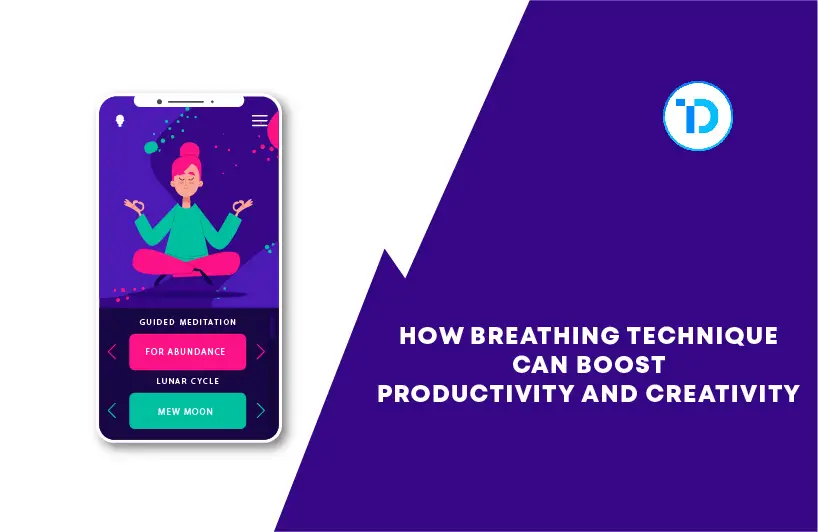When striving for increased productivity and creativity, we tend to overlook the significance of embracing a breathing technique. It’s quite remarkable how focusing on our breath can significantly enhance our efficiency. Integrating relaxation methods into our schedule can greatly impact our productivity levels and spark our imaginative abilities.
This guide will teach you relaxation strategies and their potential to enhance your acuity, concentration, and overall health.
Effective Breathing Practices for Better Productivity
Adopting specific breathing techniques can produce significant results as we strive to boost productivity. Let’s discuss a few methods that can boost daily performance.
Mindful Breathing Exercises
Mindful breathing means noticing how each breath feels as you inhale and exhale. Sit comfortably and close your blindfold. Take a few deep breaths, allowing your belly to expand on the inhale and contract on the exhale.
Next, notice how the air feels as it moves in and out of the nose. Feel the heat or cold, the weakness and feel of each breath. Don’t try to change anything, just observe. Keep doing this for a few minutes, fully focusing on the moment.
Box Breathing Method
Box breathing, also known as square breathing, is a simple yet helpful way to improve your mood. To do so, take four deep breaths through your nose. Then, wait four seconds before taking another breath.
Next, breathe slowly through your mouth for four seconds. Then, wait another four seconds, and then repeat the process. Keep doing this for a few minutes and concentrate on the consistency and relaxation of your breathing.
Diaphragmatic Breathing Routine
For more effective breathing, you can practice “abdominal breathing.” Begin by lying on your back or sitting comfortably in a chair with both feet flat on the ground. Place one hand on your stomach. The other, on your chest.
As you breathe in, focus on keeping your chest still while pushing your hands up against your stomach. Slowly let your belly move toward your spine as you inhale deeply. Engage in breathing for a few minutes each day to strengthen your diaphragm and promote.
Alternate Nostril Breathing Exercise
You can train your left and right brains to coordinate by alternating nostril breathing. Extend your spine and cover the mouth of the hole in your right cheek with your right hand. Inhale deeply through the left nostril.
Now let go of your nostril. Use your ring finger to seal it. Next, breathe in through your nostrils and exhale through your left nostrils. Repeat the process by closing your nostrils, opening them, and breathing in through the left side. Keep alternating between nostrils with each breath for a few minutes.
Square Breathing Technique
The square breathing technique is structured to promote relaxation and focus by controlling ongoing breathing. Imagine a square in your head. Taking a deep breath, pretend the count of four follows one side of the triangle.
Hold your breath as you trace the second side of the square for the count of four. Slowly inhale as you explore the third edge of the square for a count of four, then hold your breath as you complete the square for another count of four Do this a few times at the same speed and concentration squarely as it is.
Breath Counting Meditation
Breath-counting meditation is a way to stay focused and aware by counting each breath. Find a cozy sitting position and gently close your eyes. Take several deep breaths to unwind. Then, tally each inhale and exhale, beginning from one and continuing to ten.
When you reach ten, start from one. If you lose track or get distracted, just notice it without judging yourself and go back to counting from one. Try this meditation for a few minutes first, then extend it as you become more comfortable with it.
Belly Breathing Practice
Belly breathing serves as a method, for unwinding and alleviating stress. To start, sit in a position with your feet on the floor and your knees bent. You can also lie down with your legs bent or place one hand on your belly and chest. Then, take a breath through your mouth, feeling your stomach move slightly inward towards your back.
Take a breath. Focus on the feeling of your stomach moving in and out as you breathe. Besides this method, trying out breathing exercises to tackle issues such as stress or trouble sleeping can also help. Utilizing applications such as the Oxa breathing coach may offer assistance in this regard.
Conclusion
Adding breathing techniques to your schedule can significantly improve your focus. Engaging in breathing exercises such as alternate nostrils can enhance mental sharpness, concentration, and well-being. Experiment with approaches to discover the one that resonates with you the most. Integrate breathing into your everyday routines to unleash your full potential.
